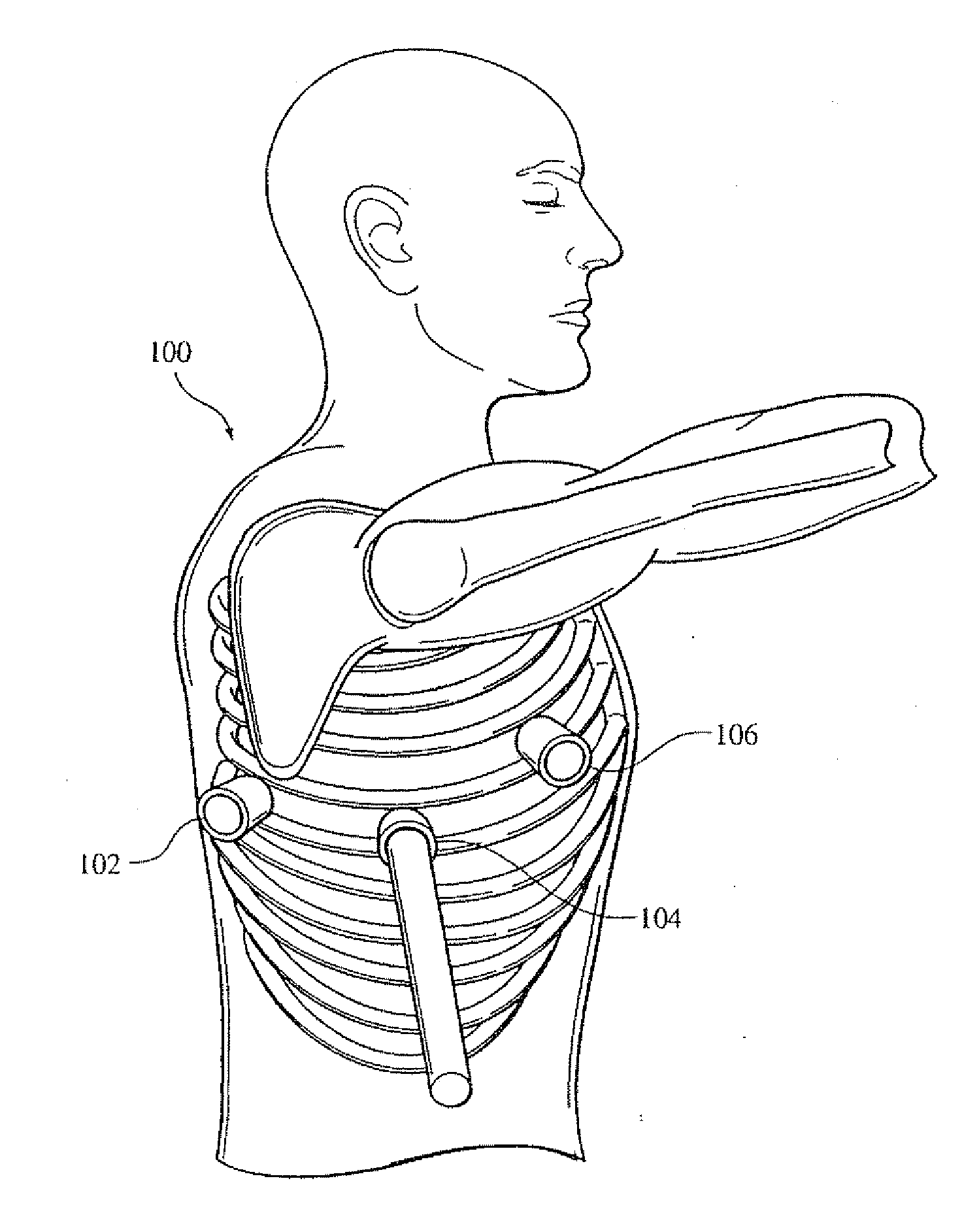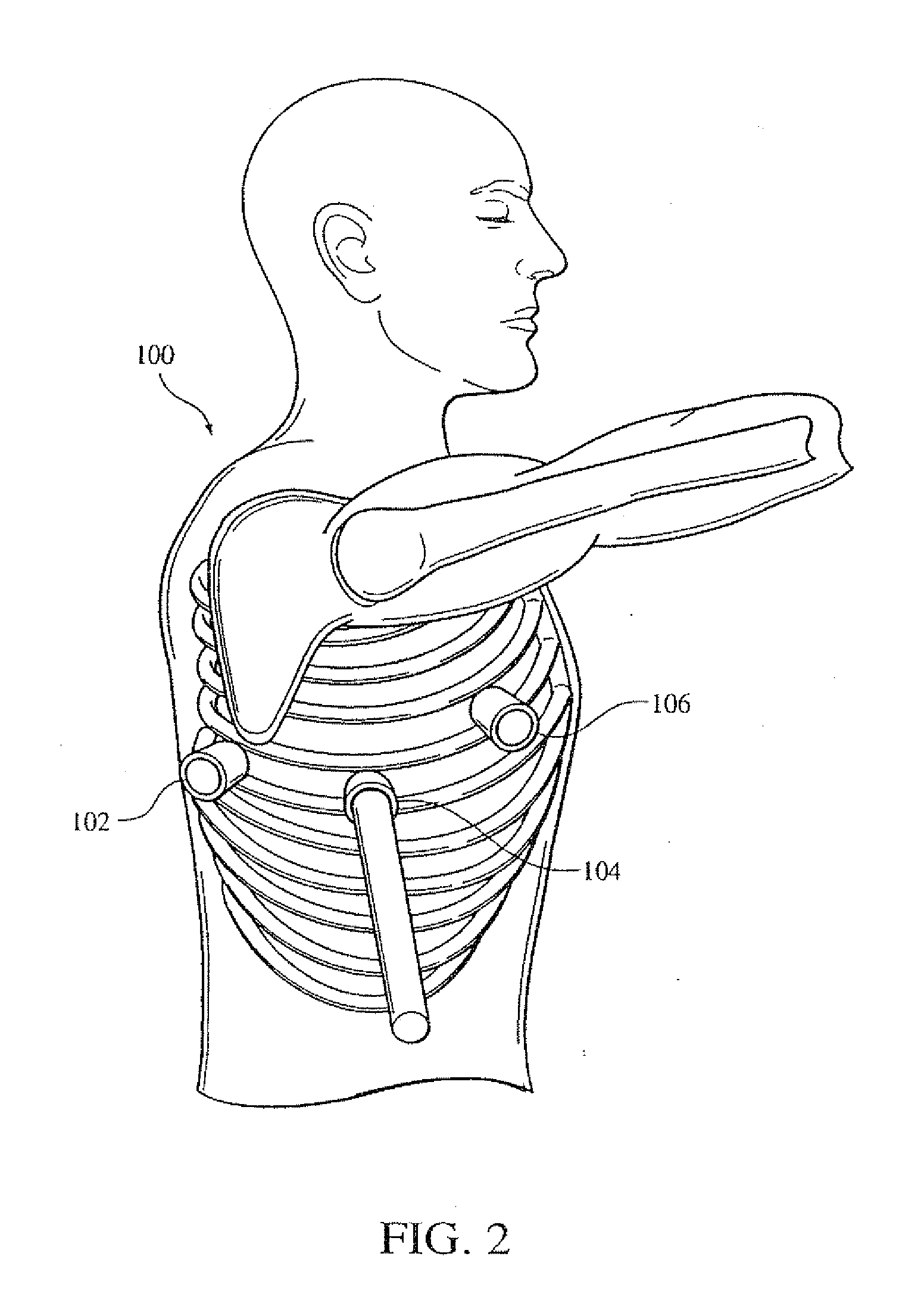Electrical stimulation of the sympathetic nerve chain
a technology of electrical stimulation and sympathetic nerve, applied in the field of electrical stimulation of sympathetic nerve chain, can solve the problems of collateral damage, inability to fully recover,
- Summary
- Abstract
- Description
- Claims
- Application Information
AI Technical Summary
Benefits of technology
Problems solved by technology
Method used
Image
Examples
example 1
[0045]Sympathetic electrical stimulation may be used, for example, to treat cardiac disorders for which the sympathetic output is abnormally high or low. The sympathetic pre-ganglionic fibers lay mainly in the sympathetic trunk ganglia from the superior cervical to the T-4 or T-5 ganglia and then, the post-ganglionic fibers, which are longer, go to the heart directly via the long cervical and thoracic sympathetic cardiac nerves. In fact, stimulation of the spinal cord relieving and increasing microcirculation of the heart may indeed be mediated through the spinal cord fibers which are sympathetic and which are going through highways / tracts in the spinal cord on their way from the central autonomic nervous system to the sympathetic ganglia. In contrast, the parasympathetic pre-ganglionic fibers to the heart reach the heart via the cardiac branches of the vagus nerve and relay in the ganglia of the cardiac plexus on in small subendothelial ganglia which are in or surrounding the heart...
example 2
[0050]Complex regional pain syndrome (CRPS) type I, commonly known as reflex sympathetic dystrophy syndrome, or RSDS, was described 25 years ago. Several synonyms have been commonly employed in describing parts or all of this syndrome, including Raynaud's syndrome, vasomotor instability, occupational digital thrombosis, arteriosclerotic obliterative disease, etc. CPRS Type II, on the other hand, also known as causalgia, is a regional pain syndrome that develops after injury to a peripheral nerve, as first described during the Civil War by Dr. W. Mitchell. Spontaneous pain develops in the territory of the affected nerve that may then spread beyond that region. Vasomotor abnormalities and focal edema may occur alone or in combination in both CRPS types I and II. These are a severely disabling group of illness with simultaneous involvement of nerve, skin, muscle, blood vessels, and bones. While there are many symptoms associated with CRPS, the only common denominator is pain. The pain ...
example 3
[0053]Hyperhydrosis is characterized by excessive sweating. The disorder can be quite pronounced, and it affects hundreds of thousands of patients, many of who are not simply embarrassed by the condition, but are in fact truly handicapped. These handicaps include constant wiping of hands, social avoidance, work avoidance, and difficulty performing tasks such as holding a steering wheel while driving. It has been estimated that 0.1-0.2% of young adults suffer from severe palmar hyperhydrosis.
[0054]In patients suffering from palmar or other forms of hyperhydrosis, the first, second, third and fourth thoracic ganglia play a major role in the abnormal signal generation to the sweat glands of the hand. Presently, there is no effective medicinal treatment for the condition. The present standard of care for the interventional treatment of palmar hyperhydrosis is the lesioning of the stellate and upper thoracic ganglia via one of several surgical approaches.
[0055]Regarding the treatment of ...
PUM
 Login to View More
Login to View More Abstract
Description
Claims
Application Information
 Login to View More
Login to View More - R&D
- Intellectual Property
- Life Sciences
- Materials
- Tech Scout
- Unparalleled Data Quality
- Higher Quality Content
- 60% Fewer Hallucinations
Browse by: Latest US Patents, China's latest patents, Technical Efficacy Thesaurus, Application Domain, Technology Topic, Popular Technical Reports.
© 2025 PatSnap. All rights reserved.Legal|Privacy policy|Modern Slavery Act Transparency Statement|Sitemap|About US| Contact US: help@patsnap.com



